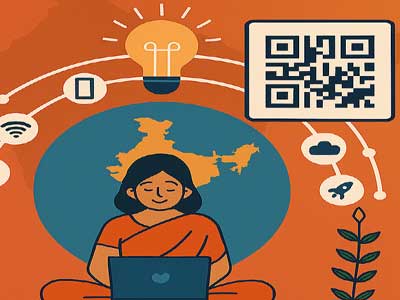On a humid summer evening in Delhi, a street vendor selling chaat taps a small soundbox after receiving payment. Within seconds, a voice announces that twenty rupees have been credited to his account. There is no exchange of coins, no fumbling for change. For the customer, it’s a quick tap of a mobile screen. For the vendor, it’s a reassurance that money has reached his bank. This ordinary scene has become so ubiquitous in India that it barely raises eyebrows. World over, subject matter experts, including economists at the International Monetary Fund, are studying UPI’s success story.
In June 2025, the IMF released a Fintech Note titled ‘Growing Retail Digital Payments: The Value of Interoperability’. Buried in its pages was a remarkable recognition: India’s Unified Payments Interface, i.e. UPI, the instant payment system launched in 2016, has ‘transformed the digital payments landscape in India’ and offers lessons to the world. The IMF’s admiration did not stop there. In its September 2025 issue of Finance & Development, the organisation carried a feature article titled ‘India’s Frictionless Payments’.
Read in Hindi: वैश्विक हुई भारत की ‘यूपीआई’ डिजिटल क्रांति
The piece described how UPI has ‘transformed India’s payment landscape and become the largest real-time payment system in the world by volume, processing more than 19 billion transactions every month’. It noted that India’s experience shows how interoperability can empower consumers, accelerate the shift away from cash, and foster innovation across the financial sector. For a country that once ran largely on cash, the IMF’s findings are testament to India’s success in revolutionising digital payments.
The story of UPI did not begin with an app, but with an idea. How could India, a country of more than a billion people, leapfrog traditional banking and move straight into the digital era? The answer lay in what policymakers later called ‘Digital Public Infrastructure’—a trinity of reforms, Jan Dhan Yojana, which opened hundreds of millions of bank accounts; Aadhaar, which gave every citizen a biometric identity as well as low-cost mobile data, driven by disruptive telecom competition, which brought the internet to the masses.
When the National Payments Corporation of India launched UPI in 2016, it built on this foundation. Unlike closed wallets, UPI was designed to be interoperable. It allowed anyone, using any app, to send money directly from one bank account to another in real time. The design was radical in its simplicity: users did not need to preload wallets or worry about which app their counterpart used.
The IMF paper highlights this innovation: interoperability ensured that UPI avoided the pitfalls of monopoly-driven closed systems. Instead, it increased users’ freedom to choose their favourite app and incentivised providers to improve quality and innovate. In short, UPI created a level playing field where banks, fintechs, and even big tech companies could all plug into the same rails.
The scale of UPI’s rise is staggering. In August, the system processed more than 20 billion transactions worth over ₹24.85 Lakh Crore. Further strengthening this growth trajectory, the National Payments Corporation of India has revised the Unified Payments Interface transaction limit for Person-to-Merchant payments. With effect from 15th September, users are able to make merchant transactions of up to ₹10 lakh per day for select verified categories, thereby facilitating greater adoption of digital payments for high-value transactions.
Today, UPI accounts for 85 per cent of all digital transactions in India. This is no longer just a financial statistic. It is a reflection of how deeply UPI has been woven into the daily lives of ordinary Indians — from vegetable vendors in small towns to women entrepreneurs in rural markets.
The IMF’s report reinforces a sentiment widely shared across India, that UPI is not merely a tool of convenience, but an instrument of empowerment. The chai seller in Delhi can trust his digital earnings as much as hard cash. A domestic worker in Patna can send money home instantly, without standing in queues. A farmer in Madhya Pradesh can accept payments directly into his bank account, reducing dependence on middlemen. For the Government, this is a matter of pride. More than 89 per cent of adults in India now have bank accounts, many enabled by Aadhaar and Jan Dhan Yojana, and UPI has become the bridge connecting them to the digital economy.
What began as an Indian innovation is today crossing borders through partnerships led by NPCI International Payments Limited. In Singapore, UPI has been linked with PayNow to enable instant cross-border transfers. In the UAE and Mauritius, Indian travellers can pay for goods and services using UPI. In France, Indian tourists can now pay at the Eiffel Tower by simply scanning a QR code and settling the bill in rupees. Nepal and Bhutan have already adopted UPI for transfers, and talks are ongoing with central banks and fintechs across Asia, Africa, and Europe.
This is a quiet but profound transformation. For decades, global finance was defined by Western institutions and credit networks. Now, an Indian-built public digital platform is being showcased as an export. UPI is not just carrying money across borders; it is carrying India’s reputation for innovation, inclusion, and scale.
In praising UPI, the IMF also pointed to the architecture behind it — what India calls its Digital Public Infrastructure. UPI did not succeed in isolation. It grew on top of Aadhaar, which gave every Indian a unique identity, and Jan Dhan Yojana, which ensured that hundreds of millions had bank accounts. Add to this the world’s lowest-cost mobile data, and the stage was set for UPI to flourish.
This layered approach — identity, accounts, connectivity, and then payments — is what makes the Indian model attractive to other nations. The IMF notes that countries struggling with cash dependence can replicate this formula: build basic infrastructure, create open payment rails, and then allow private companies to innovate on top. The key, it stresses, is interoperability. By keeping the system open, India ensured competition among apps and banks, which improved service quality and built user trust.
The Delhi street vendor who listens to his soundbox may not be aware of the recognition UPI has received from the world and development institutions like the IMF. But his daily experience — quick, secure, and cashless transactions — is precisely what caught the world’s attention. In him, and millions like him, lies the story of how India digitised trust itself.
UPI today is more than a payment interface. It is the face of India’s innovation, the embodiment of its inclusive growth, and now, a beacon for nations seeking to leap from cash to digital. UPI has become not just India’s success story, but a global symbol of possibility.
From cash to clicks, India’s digital rails are carrying the country onto the world stage — and the world is listening.


















Related Items
Redefining Indian Highways; Driving innovation, Delivering connectivity…
India, from crowded bazaars to digital browsers…
India reframes its renewable revolution